Grab your magnifying glass and deerstalker hat as we prepare to unravel how to write mystery fiction using the Sleuth’s Journey Plot Structure Template in Plottr.
Whether your story is a cozy mystery with a kooky amateur detective or a hardboiled police procedural with a grizzled, tired investigator, the game is afoot! And the Sleuth’s Journey structure can help you make all the pieces fit together just right.
What is the Sleuth’s Journey?
The Sleuth’s Journey plot structure is a mystery novel plotting formula created by author and Plottr Education Lead Troy Lambert, based on Joseph Campbell’s popular Hero’s Journey.
Put simply, it’s a reimagining of that classic adventure story structure, redesigned to suit the intricacies of the mystery genre.
What a video by Troy on the revised version of this template, and keep reading for a detailed breakdown of its beats and plotlines.
![[REVISED] The Sleuth's Journey Plot Template](https://plottr.com/wp-content/cache/flying-press/f80731443d049fac0e5058f7291a554d.jpg)
Who is the Sleuth’s Journey Plot Structure Template For?
This plotting template is for authors wanting to create a solid mystery novel plot and hit all the appropriate beats that mystery readers expect.
This means it will help you plan out not only the clues and red herrings to be discovered by your sleuth, but also the victim’s story, the villain’s story, and any B-story plots— such as a romantic sub-plot — and, ultimately, how they all weave together.
If you’re new to mystery writing and want to learn how to write mystery fiction, or just want to move faster with quick-reference materials at the ready, this is the plot structure template for you.
Plot Points of the Sleuth’s Journey
Plottr’s Sleuth’s Journey Plot Structure Template follows four plotlines: the Sleuth’s Journey, the Victim’s Journey, the Villain’s Journey, and a Sub-Plot (Romance, etc.).
Each of these journeys has a different number of story beats, with the most (17) included in the Sleuth’s Journey.
Let’s take a look at these beats in more detail.
Beats in the Sleuth’s Journey
Beat 1: The Sleuth’s Ordinary World
This is the world the sleuth lives in. It can be action-packed. Think of James Bond movies, the intro to John Wick, or the opening to other thrillers.
In the movie Enola Holmes 2, the story opens with Enola, who is working as a detective, running from the police through the streets of London. This is actually a flash forward, but we quickly go back to the beginning of the story, during which Enola has no clients because she’s a woman and is on the verge of closing her detective agency.
Beat 2: The Sleuth’s Word Disrupted
The sleuth learns of the crime that will be central to your story, and their ordinary world is disrupted, because:
- They are hired to solve the crime,
- They are assigned the case, or
- They are somehow drawn into the investigation.
This beat should include one clue for the sleuth to receive, the details of which will play a role later in the mystery.
A young girl named Bessie appears and wants to hire Enola to find her missing sister, who is actually another of the match girls who work at the match factory run by the Lyon family. Bessie tells Enola that everyone thinks Sarah ran away, but Bessie says Sarah wouldn’t do that.
Beat 3: Reluctance to Take the Case
For some reason, your sleuth will hesitate to take the case in this scene.
An amateur sleuth might feel pulled to investigate, but also unqualified or unprepared for the emotional investment of investigating.
If the sleuth is a more seasoned detective, the refusal of the call may occur because they simply don’t want the case, or they may fear they won’t be assigned to it. Often, the refusal of the call is not the decision of the sleuth, but of their superiors or those around them.
Enola does not refuse to take the case, but she does meet resistance from Mae, another of the match girls who says that posh girls like Enola don’t have any business being part of “this fight.”
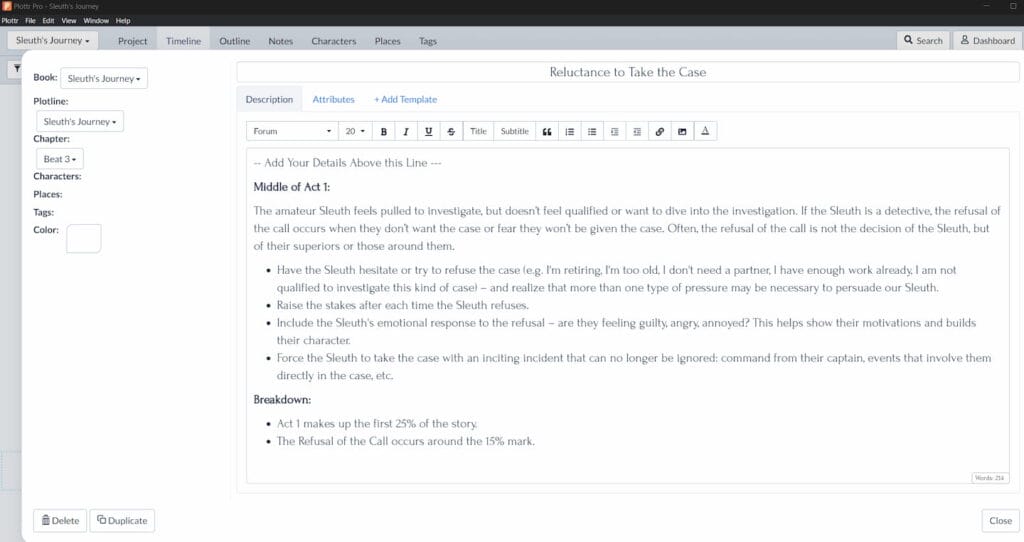
Beat 4: The New Partner
This is an optional beat, but one in which the sleuth meets a new partner — their sidekick for this story. This person, although often their polar opposite, gives them the confidence and tools they need to succeed.
The partner must get the sleuth over their previous objections, which often takes the form of a (not so) gentle nudge.
Though Enola does not work with a partner all the time, she does temporarily team up with her brother Sherlock and Lord Tewkesbury, the young man she met and had adventures with in the first movie, at different points in the current story.
Beat 5: Set the Sleuth on the Path
Set the sleuth on the path toward solving the mystery. Offer plausible suspects, all of whom appear to have had motive, means, and opportunity to commit the crime. Select the most likely suspects, and have the sleuth question them. One of these suspects will turn out to be the actual perpetrator.
Enola poses as a match girl to get into the factory and is examined for typhus, which has been killing match girls for two years, when she enters.
She sneaks into the office of Mr. Crouch, the supervisor, with whom Sarah fought. Enola discovers red-tipped matches (though the ones made in the factory are white-tipped) and that some pages have been ripped out of a ledger. She also overhears a heated exchange in a nearby room between several well-dressed men. As they leave, one of them is accompanied by his secretary, to whom he talks rather rudely.
Enola discovers that Sarah was also working as a dancer at the Paragon Theatre. Through a series of clues and questioning a staffer backstage, she finds a love poem apparently written by Sarah’s admirer or lover and signed with a red poppy. When she deciphers a hidden address in the love poem, she goes there and finds that Mae has been stabbed.
Police Inspector Lestrade and Superintendent Grail soon arrive and find her over Mae’s body with blood on her hands and attempt to arrest her. Enola runs and makes her escape, which points back to the chase in the opening of the movie.
Beat 6: The First Erroneous Conclusion (Try/Fail)
Direct the investigation toward a conclusion that later proves to be erroneous. Usually, this conclusion and its failure do provide the sleuth with some new information that sets them on the path to the correct answer, or at least the next try/fail.
This is a good place to introduce a clue the sleuth does not realize is important, but which pays off later.
Based on something Tewkesbury says while discussing flowers, Enola realizes that the poppy at the bottom of the love poem was actually a Sweet William flower. This leads her to believe William Lyon, the son of the match factory owner and who was in the heated meeting at the factory, is Mae’s killer and that he’s after Sarah to kill her too.
One of the clues Enola finds during the early part of her investigation is a partially burned piece of paper in Sarah’s room that says “12 March” on it. She discovers that it’s not a date at all but rather part of an address where a ball hosted by the Lyon family is being held.
Beat 7: Facts About Suspects
After the first erroneous conclusion, your sleuth will double down on investigations. This will create a sense of urgency and tension.
Enola maneuvers her way into the Lyons’ ball in search of William Lyon. She can’t talk to him alone because she is unchaperoned, even though at the same ball she sees him in a room alone with a pretty young woman.
Enola walks up to an upper level to watch the dancers below. The secretary she’d seen at the factory steps up next to her and gives her tips about how to send messages with fans and how the social structure of upper society is all a game.
Enola learns the secretary’s name is Mira Troy and she works for Treasury Minister McIntyre.
Enola uses Mira’s tips to get William Lyon’s name onto her dance card, and while they’re dancing the waltz she questions him about Sarah’s disappearance. He’s startled and tries to run away, but she prevents it with a threat of screaming. He tells her to meet him in the library at midnight, but the meeting is thwarted first by Tewkesbury’s arrival and then the police who arrest Enola for Mae’s murder.
Beat 8: Broaden the Investigation
At this stage in your story, the protagonist and (most) allies have survived the previous tests on their journey into the unknown world and can pause for a moment.
If they have been hit by setbacks during the tests, this is an opportunity for them to regroup and create their plan for the final confrontation by gathering tools, preparing plans, or cutting down the enemy’s ranks.
It may also be a good place for a morale booster or a visit from the mentor to reconfirm the sleuth’s faith in their abilities.
When Sherlock is unable to secure Enola’s release from jail, he turns to his mother’s friend Edith and, through her, his mother for help. They break Enola out of jail. As they escape, Enola and her mother go over all the clues of the case. Her mother asks her an intriguing question: if girls like Sarah are expendable, why does everyone want to find her so much? It’s because she has something they want — the missing pages from the register in Mr. Crouch’s office.
Sherlock, meanwhile, is working on his own case about missing government funds and realizes that his and Enola’s cases are connected. He realizes that all the clues he’s collected are a cipher that matches the steps of various dances and that the secret message in the cipher is from his nemesis, Moriarty.
Beat 9: The Sleuth’s Background
Through the subplot and other relationships, we start to learn more about the sleuth and their background. This establishes what drives them, haunts them, or may be missing in their life.
Spending time on this theme offers the reader a breather from all the action, although there can be some personal action in this scene.
Enola’s mother, Eudoria, tells her that by teaching her to be independent, she may have inadvertently made her believe she has to be alone and therefore lonely. She lets Enola know that it’s okay to have others to depend on. Eudoria also praises the good work that Tewkesbury is doing in the House of Lords.
Beat 10: Change of Focus (Try/Fail #2)
Once the sleuth has a plan and a personal reason to solve the case, they must face their biggest test, which leads them to their darkest moment. They have been on the wrong track, and tragic events make that obvious.
Enola goes to Bessie’s home to move her to a safer location. While there, she notices some strange substances in a couple of Sarah’s plants (one of which is dead). One of the substances is white while the other is red — just like the match tips being made by the factory now versus the ones two years ago. She realizes that it’s not typhus that’s been killing the match girls; it’s the change in phosphorus used to make the newer, cheaper matches.
Enola goes to Tewkesbury and tells him that Sarah has proof that the phosphorus is killing the match girls and that the owners knew it. Cicily, the woman who had been with William, comes to Tewkesbury’s place saying she has something to tell him but quickly leaves.
When Tewkesbury tells Enola that the fan message he’d sent Enola earlier meant he loves her, Enola remembers she saw Cicily send William the same message at the ball. She realizes that Cicily is Sarah and that she and William have been working together to expose the corruption at his father’s match factory.
Beat 11: Reveal Hidden Motives
The sleuth has really been put through it at the midpoint of our story, and now things turn around for them. Their hunch about the motive for the crime they were chasing may have been wrong, but now new, previously hidden motives are revealed through actions taken by the sleuth.
Enola and Tewkesbury go to the match factory at night to investigate and find Sherlock there too, led to the factory by the clues in his own case. They find William there, dead, but also find a ripped piece of sheet music like one that was found earlier.
Tewkesbury tells them the name of the piece of music refers to the upper balcony of the Paragon Theatre. They go there and find all the evidence Sarah, Mae, and William had collected against the elder Lyon and McIntyre, who were working together to profit off the cheaper phosphorus even though it was killing girls.
Sarah shows up, and it becomes clear she wanted Tewkesbury to use his position in the House of Lords to bring the situation to light.
Beat 12: The Impossible Solution
While the true motive is now clear, there are still issues the sleuth must face, and the solution seems to be difficult, if not impossible. Attempts to solve the crime have stymied the sleuth. Misinterpretation of clues or mistaken conclusions have led them in the wrong direction.
Grail and the police show up, and a fight ensues. Enola, Sherlock, and Tewkesbury are injured but survive, victorious.
Beat 13: Reveal the Wrong Turn
The sleuth made a wrong assumption about the motive or other facts of the crime. This caused them to take a wrong turn, which they now realize and work to correct.
McIntyre arrives with Lestrade and commands the latter to arrest Sarah for theft and blackmail.
Beat 14: The Sleuth Has Answers
This is a short beat where the sleuth takes what they have learned in the last two beats, weighs the evidence and information they have been given, and now looks to prove the conclusion they’ve already come to.
The reader may not know what is going on exactly, but they will have a hint as to what the sleuth assumes and why they assume it.
While Enola argues that Sarah has proof of McIntyre’s and Lyon’s crimes, Sherlock reveals that he’s the one who told McIntyre where they would be to draw out the real blackmailer, Mira Troy, and that Mira is actually Moriarty.
Beat 15: The Final Reveal
Once the sleuth has the answer, this beat shows them finding the final clue they need to solve the crime and revealing it to the reader. This clue should fulfill a promise made in Act 1 and the reader should feel satisfied that the loose ends have been wrapped up.
This is another quick beat and could be combined with the previous one. The only thing left is to catch the villain; the final confrontation or chase scene often occurs at this point in the story.
It’s revealed that Moriarty had hired Grail to track down the contract between Lyon and McIntyre so she could blackmail them. McIntyre grabs all the papers that prove his crimes and burns them before anyone can stop him. Moriarty is arrested, but McIntyre walks free.
Beat 16: Caught
This is the true climax of the story — the final and most dangerous encounter between the sleuth and the villain. This is the definitive and greatest test of the sleuth’s determination to solve the case. With the solution in hand, it is time for the sleuth to confront the villain, often alone and without the support they need.
With time running out and pressure at its highest, the sleuth captures the villain, but there is often a sacrifice involved.
After Sarah and Bessie, aided by Enola, lead the match girls out on a strike, Tewkesbury uses his position to bring McIntyre to justice for corruption.
Beat 17: Denouement
With the case solved and the perpetrator brought to justice, the sleuth is now a changed person with new strength and confidence. This is an opportunity to reaffirm their growth. The sleuth can choose to settle into a life of comfort until the next crisis arises, or they may seek a new mystery and adventure right away.
If this story is part of a series, you can leave some loose threads or provide a hook for the next book here.
Enola appreciates Sherlock’s offer to work together, but she’d always be in his shadow. Circumstances may require it at some point, however, as it’s revealed that Moriarty has escaped and is on the run. In the meantime, at least part of Enola’s time will be devoted to her new romance with Tewkesbury.
The Victim’s Journey
This journey only has three beats, which line up time-wise with beats two, five, and eight of the Sleuth’s Journey.
Beat 2: The Victim’s World Disrupted
The victim is introduced here, with special attention given to their character and life. Their ordinary world is disrupted when they are killed, robbed, assaulted, or otherwise victimized by the central crime in the story.
Though there are various victims in Enola Holmes 2, the main focus is Sarah Chapman, who has disappeared from her home and her job at the Lyons’ match factory.
Beat 5: Empathy Trigger
The sleuth, and therefore the reader, learns something here about the victim that makes them feel empathy. The sleuth is more motivated to solve the case because of this information.
Enola sees how strictly the match girls are treated at work and finds out that Sarah stole some pages from a register in the safe of Mr. Crouch’s office. Though it’s not explicitly stated, the viewer gets the feeling that this stolen information has something to do with nefarious goings-on at the factory.
It’s later revealed that the missing pages are the names of the girls who have died because of the cheaper phosphorus being used at the factory to make the villains’ money.
Beat 8: The Sleuth and the Victim
Information gathered through interviews, or the discovery of physical evidence, should reveal new facts about the victim that will help the sleuth solve the crime.
It also fleshes out their character, and perhaps connects the victim to the sleuth in some way, thus reminding the reader to care about just who was victimized by the case we’re investigating.
A trail of clues lead to the revelation that Sarah has been in hiding and working secretly with her love, William Lyon, to reveal the corruption that has led to the deaths of so many match girls. In the process, Sarah also loses William when he is killed. Enola is determined to make the villains pay for those deaths and what Sarah has lost.
The Villain’s Journey
Because this character is still alive and active, unlike the victim, they have more beats in their plotline: six in total. They align time-wise with beats 1, 2, 4, 10, 13, and 16 in the Sleuth’s Journey plotline.
Beat 1: The Villain’s Ordinary World
As the story begins, the villain is in their ordinary world … and something is not quite right. For example, an important project they’ve been working on has gone wrong; they feel betrayed by their government; they’ve witnessed a loved one die; or they’ve given in to their darkest desires.
Lyon and McIntyre have been making themselves even richer by using cheaper phosphorus in the match factory, at the expense of many match girls’ lives.
Beat 2: The Villain’s World Disrupted
The villain takes action and commits a serious offense or crime. They may steal, kill, rob, or kidnap, but whatever it is, they are now past the point of no return and are beginning on the path toward their ultimate goal. They are now unquestionably the story’s villain.
Someone starts to blackmail them after proof of their corruption is stolen from the factory office. They believe the blackmailer to be Sarah Chapman.
Beat 4: The Criminal Preparation
The villain may be seen preparing a partner or a team, if you are showing the reader their point of view.
Otherwise, your sleuth may be called to another in a series of crimes — something that clues them into a sinister person or group who may be behind them all. This may also be related to the new partner; the villain may even know them.
Enola overhears the heated discussion between Lyon and McIntyre in the room close to the match factory office. As the men leave, she sees McIntyre’s secretary, Mira Troy, being talked down to by him. She talks to Sherlock about her case, and he tells her about his. Unknown to them both, the cases are connected.
Beat 10: The Villain’s Midpoint
This is a time of victory for the villain. Even if we do not see this through their perspective, we should see that the bad triumphs at this point when the good is at their lowest. The villain is always on the opposite track from your protagonist.
McIntyre burns the proof of his corruption and has Moriarty (Mira Troy) arrested for being the real blackmailer.
Beat 13: On the Run
The sleuth now has many of the facts they will need to solve the case. The villain is getting close to success and getting away with things. But alas, the sleuth stands in their way. In this beat, you should:
- Show the villain’s frustration, either from their point of view or based on what the sleuth observes.
- Take away the villain’s hope and make them desperate for success.
Without the proof of his crimes, Enola has to let McIntyre walk away free. But she’s not giving up on making him and Lyon pay. She aids Sarah and Bessie in leading the match girls to walk off their jobs in a strike.
Beat 16: Ordeal, Death, Rebirth
Victory is snatched away by the sleuth … and the villain is left to face the consequences. They may be destroyed, killed, banished, jailed, or convinced to turn back to the path of good. No matter the outcome, the villain is no longer a threat.
With the help of Tewkesbury, justice is served when McIntyre is arrested.
Sub-plot (romance, etc.)
This section has the second highest number of beats, numbering eight. These align with beats 1, 2, 5, 7, 9, 13, 16, and 17 in the Sleuth’s Journey plotline.
Beat 1: B-Story Opening Image/Hook
Whatever your subplot is, it is shown as a part of the sleuth’s ordinary world. This can be a family story, a budding romance, or another mystery or case that is happening at the same time as the main storyline.
Enola is eating her breakfast in a public park along the path Tewkesbury takes on his way to the House of Lords. He notices her and stops to talk. She says she’s noticed that he’s popular in the society pages of the newspaper — quite the eligible bachelor.
Enola is jealous but tells herself that her job is more important, that romance would endanger her independence. But when he says that he wrote to her and she didn’t answer, she responds that she’s been busy with work (even though she’s not had any clients).
Beat 2: B-Story Disrupted
The love interest or the B-Story is disrupted by the same events that disrupt the sleuth’s ordinary world. The marriage retreat is postponed, or the beach vacation, or the sleuth is pulled off another case, forced to postpone retirement — the possibilities go on.
This is a conflict that will always be at odds with and making a mess of the main storyline.
When Tewkesbury offers his help if she ever needs it and says, “You know where to find me,” that causes Enola to remember the love poem sent to Sarah. In a lightbulb moment, she realizes that it’s a coded message telling Sarah where her potential lover is.
Beat 5: End of the Beginning
The decision to take the case spells the end of the original plan for the B-Story, whatever that might be. In this case of a romance, this jeopardizes the relationship.
While at the Lyons’ ball, Enola is annoyed seeing the pretty young women gathered around Tewkesbury. She focuses instead on her planned meeting with William Lyon and how she hopes that will lead her to Sarah’s whereabouts.
Enola uses Tewkesbury to quickly teach her to dance so she can dance with William and question him. When some ladies knock on the door of the bathroom where Tewkesbury and Enola are dancing, he has to make his escape out the window.
Beat 7: Try/Fail #1
As the sleuth learns more about the case, a possible resolution of the B-Story occurs. Because of the case, however, this does not work out. It is the subplot’s first try/fail. It generally comes as a consequence of the first try/fail in the main storyline.
Enola has kept herself at a distance from Tewkesbury, despite her feelings for him, because she doesn’t want to lose the independence and self-reliance that her mother taught her was so important. But, to Enola’s surprise, her mother now tells her that being independent doesn’t mean that she has to be alone. She tells her that being with others will actually make her stronger.
Beat 9: Midpoint
We learn here why the B-Story is not working out. Mirroring Beat 9 of the main storyline, the reason here comes from what we learn about the sleuth’s background. Remember: this is the personal trait, memory, or circumstance that causes them to be so invested in the case.
Enola empathizes with the girls working at the match factory because they are making their own ways in the world, too. When Tewkesbury tells her he’s not looking for a wife because his political work consumes him, it mirrors how she’s consumed by her detective work.
Beat 13: Crisis
There is a crisis in the B-Story, and it is often related to a lesson learned as part of the error in the main plot. This adds tension and occurs just as the villain is on the run, and the sleuth learns of their wrong turn.
The pretty girl Cicily arrives at Tewkesbury’s home while Enola hides behind the potted plants. Enola belatedly realizes Cicily is Sarah and runs after her, leaving Tewkesbury behind. But when she gets outside, Sarah is gone. When she turns around, Tewkesbury confesses he loves Enola. She confesses she loves him as well.
Beat 16: Climax
As the final confrontation approaches, the A and B stories both reach climaxes that are related to each other, resolving both plot lines.
During the fight with Grail and the corrupt police officers, Tewkesbury cries out Enola’s name in fear as he watches her fall from a high walkway in the theatre. When she lifts herself from the floor, she and Tewkesbury run to each other to make sure the other is okay.
Beat 17: Final Image/Resolution
What is the lesson learned, the character trait developed, or the heart won? How does the story resolve in a positive way for the sleuth? Show these insights at the conclusion of your story.
Enola and Tewkesbury go out on a date, walking arm in arm.
We know what you’re thinking: that’s a lot of cards. Things weave together pretty smoothly once you’re in the zone, but it’s important to remember that you can adjust this or any other template within Plottr to fit your specific needs.
In fact, Troy says in this video that, for one of his own series, he uses slightly fewer beats than are shown on the template.
How Do You Use the Sleuth’s Journey Plot Structure Template in Plottr?
To begin, make sure you have an active Plottr membership plan (you can get a free 30-day trial if you need to!). Then, follow these steps to get started with the Sleuth’s Journey structure.
- Step 1: Within the Files tab in the dashboard, click Create From Template

- Step 2: Choose Sleuth’s Journey from the list of templates, then click the orange Create New Project button
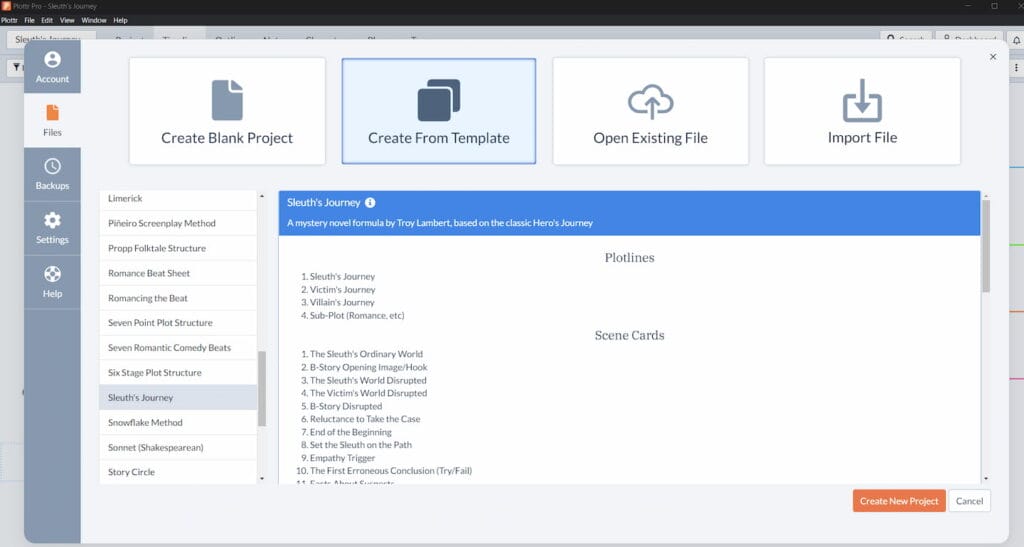
- Step 3: Name your project. Once you’ve saved it, you’ll be able to access it from your dashboard at any time
- Step 4: You will see this timeline next. Use the horizontal slider bar at the bottom to see all of the beats within the four plotlines and get a feel for the overall structure
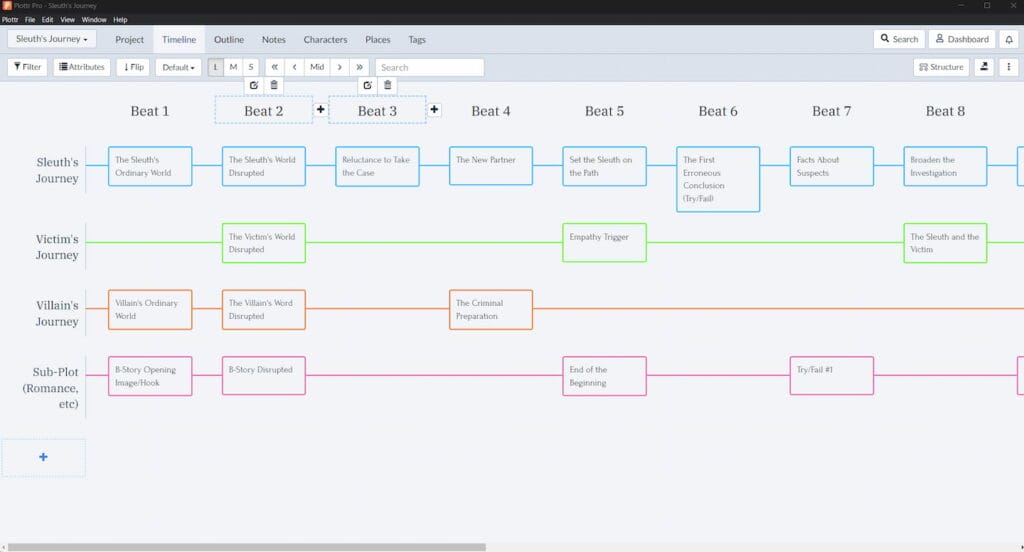
- Step 5: Get writing! Each of those beat boxes is clickable; select one to read about what should go there and input your own story details
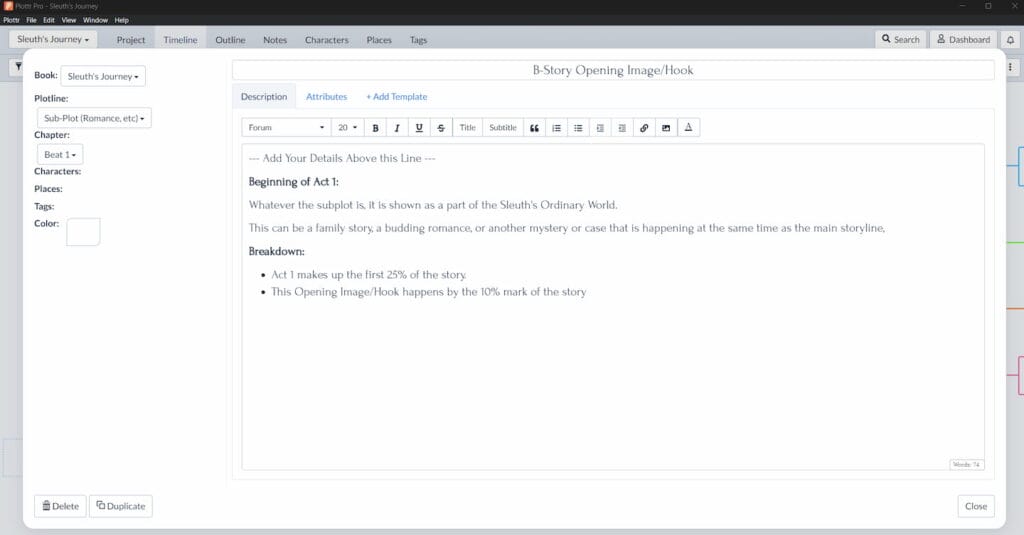
Note: At the end of each beat’s section description, you’ll see some breakdown information — such as how much of your book each part of the story should occupy. For example, the opening image/hook in the above example should take up approximately 10% of the story.
This plot structure template works well with other plot and character templates in Plottr you can add to your outline, such as:
- Cozy Mystery Plot Template
- Maslow’s Hierarchy of Needs (Character Template)
- The Story Circle (Plot Template)
Crack the Case
Is your mind full of story ideas just waiting to fill the Sleuth’s Journey Plot Structure Template? Then it’s time to open Plottr and start to make that story structure magic. If you don’t yet have Plottr, get a free 30-day trial and join free tutorials on Tuesdays to learn the ropes.

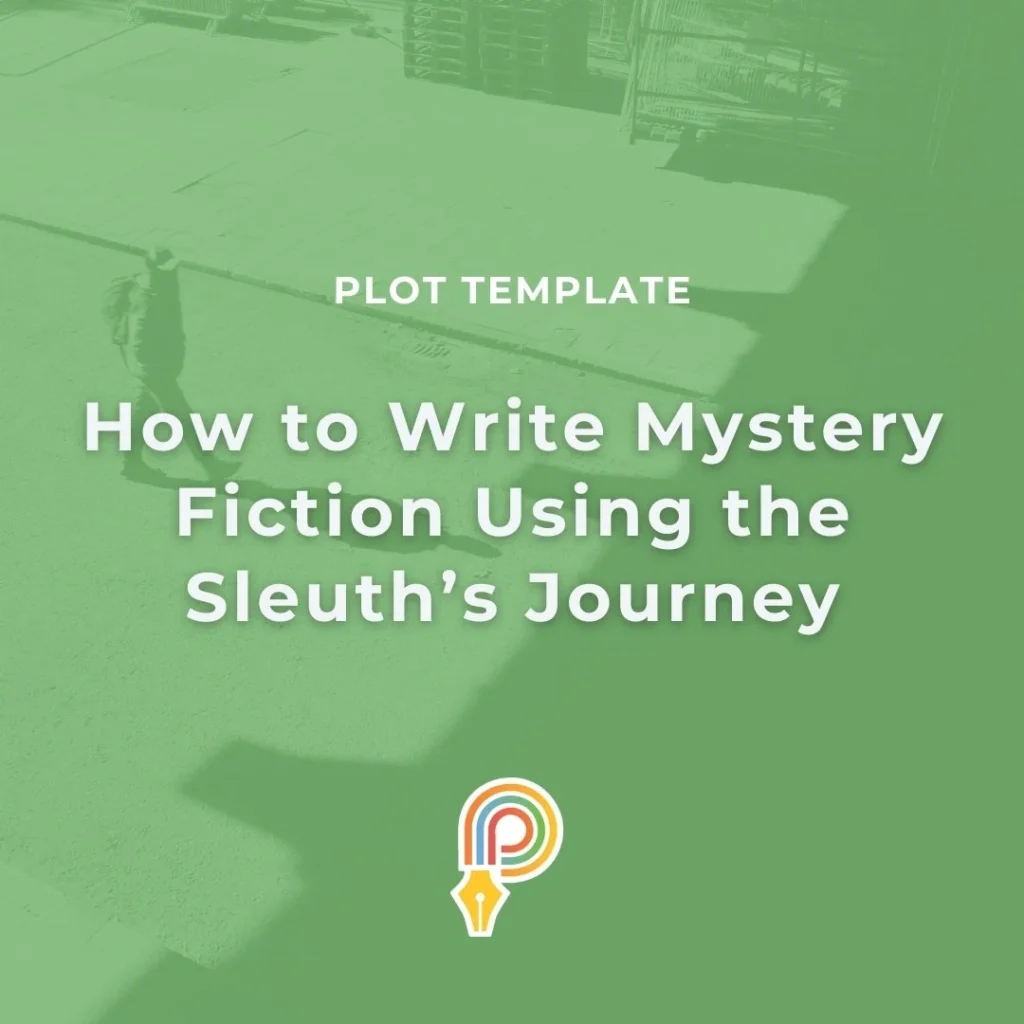





Comments